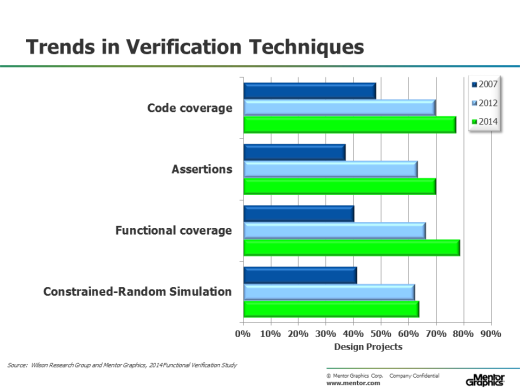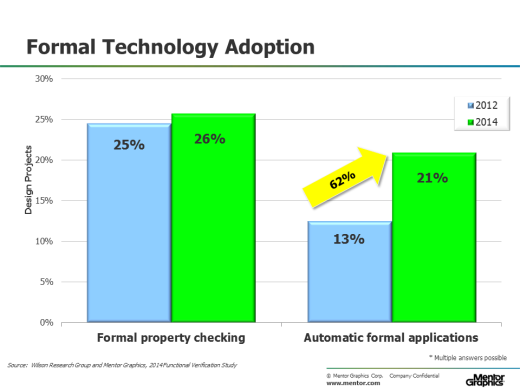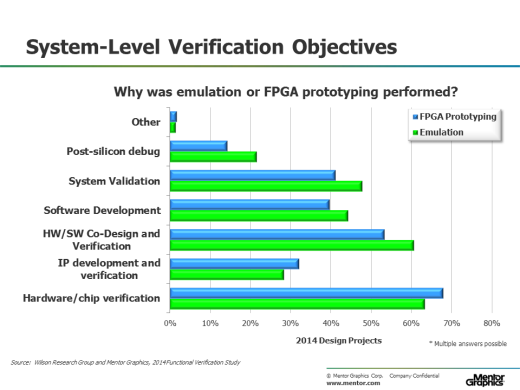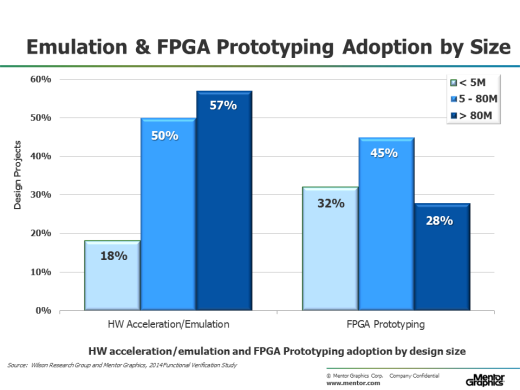Part 9: The 2014 Wilson Research Group Functional Verification Study
ASIC/IC Verification Technology Adoption Trends
This blog is a continuation of a series of blogs related to the 2014 Wilson Research Group Functional Verification Study (click here). In my previous blog (click here), I focused on the growing ASIC/IC design project resource trends due to rising design complexity. In this blog I examine various verification technology adoption trends.
Dynamic Verification Techniques
Figure 1 shows the ASIC/IC adoption trends for various simulation-based techniques from 2007 through 2014, which include code coverage, assertions, functional coverage, and constrained-random simulation.
Figure 1. ASIC/IC Dynamic Verification Technology Adoption Trends
One observation from these adoption trends is that the electronic design industry is maturing its verification processes. This maturity is likely due to the growing complexity of designs as discussed in the previous section. Another observation is that constrained-random simulation adoption appears to be leveling off. This trend is likely due to the scaling limitations of constrained-random simulation. This technique generally works well at the IP block or subsystem level in simulation, but does not scale to the entire SoC integration level.
ASIC/IC Static Verification Techniques
Figure 2 shows the ASIC/IC adoption trends for formal property checking (e.g., model checking), as well as automatic formal applications (e.g., SoC integration connectivity checking, deadlock detection, X semantic safety checks, coverage reachability analysis, and many other properties that can be automatically extracted and then formally proven). Formal property checking traditionally has been a high-effort process requiring specialized skills and expertise. However, the recent emergence of automatic formal applications provides narrowly focused solutions and does not require specialized skills to adopt. While formal property checking adoption is experiencing incremental growth between 2012 and 2014, the adoption of automatic formal applications increased by 62 percent. In general, formal solutions (i.e., formal property checking combined with automatic formal applications) are one of the fastest growing segments in functional verification.
Figure 2. ASIC/IC Formal Technology Adoption
Emulation and FPGA Prototyping
Historically, the simulation market has depended on processor frequency scaling as one means of continual improvement in simulation performance. However, as processor frequency scaling levels off, simulation-based techniques are unable to keep up with today’s growing complexity. This is particularly true when simulating large designs that include both software and embedded processor core models. Hence, acceleration techniques are now required to extend ASIC/IC verification performance for very large designs. In fact, emulation and FPGA prototyping have become key platforms for SoC integration verification where both hardware and software are integrated into a system for the first time. In addition to SoC verification, emulation and FPGA prototyping are also used today as a platform for software development.
Today, 35 percent of the industry has adopted emulation, while 33 percent of the industry has adopted FPGA prototyping. Figure 3 describes various reasons why projects are using these techniques. You might note that the results do not sum to 100 percent since multiple answers were accepted from each study participant. Also, we are unable to show trend analysis here since previous studies did not examine this aspect of functional verification.
Figure 3. Why Was Emulation or FPGA Prototyping Used?
Figure 4 partitions the data for emulation and FPGA prototyping adoption by the design size as follows: less than 5M gates, 5M to 80M gates, and greater than 80M gates. Notice that the adoption of emulation continues to increase as design sizes increase. However, the adoption of FPGA prototyping rapidly drops off as design sizes increase beyond 80M gates. Actually, the drop-off point is more likely around 40M gates or so since this is the average capacity limit of many of today’s FPGAs. This graph illustrates one of the problems with adopting FPGA prototyping of very large designs. That is, there can be an increased engineering effort required to partition designs across multiple FPGAs. However, better FPGA partitioning solutions are now emerging from EDA to address these challenges. In addition, better FPGA debugging solutions are also emerging from EDA to address today’s lab visibility challenges. Hence, I anticipate seeing an increase in adoption of FPGA prototyping for larger gate counts as time goes forward.
Figure 4. Emulation and FPGA Prototyping Adoption by Design Size
In my next blog (click here) I plan to discuss various ASIC/IC language and library adoption trends.
Quick links to the 2014 Wilson Research Group Study results
- Prologue: The 2014 Wilson Research Group Functional Verification Study
- Understanding and Minimizing Study Bias
- Part 1 – FPGA Design Trends
- Part 2 – FPGA Verification Effort Trends
- Part 3 – FPGA Verification Effort Trends (Continued)
- Part 4 – FPGA Verification Effectiveness Trends
- Part 5 – FPGA Verification Technology Adoption Trends
- Part 6 – FPGA Verification Language and Library Adoption Trends
- Part 7 – ASIC/IC Design Trends
- Part 8 – ASIC/IC Resource Trends
- Part 9 – ASIC/IC Verification Technology Adoption Trends
- Part 10 – ASIC/IC Language and Library Adoption Trends
- Part 11 – ASIC/IC Power Management Trends
- Part 12 – ASIC/IC Verification Results Trends
- Conclusion: The 2014 Wilson Research Group Functional Verification Study







Comments